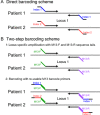Flexible and Scalable Full-Length CYP2D6 Long Amplicon PacBio Sequencing
- PMID: 28044414
- PMCID: PMC5324676
- DOI: 10.1002/humu.23166
Flexible and Scalable Full-Length CYP2D6 Long Amplicon PacBio Sequencing
Abstract
Cytochrome P450 2D6 (CYP2D6) is among the most important genes involved in drug metabolism. Specific variants are associated with changes in the enzyme's amount and activity. Multiple technologies exist to determine these variants, like the AmpliChip CYP450 test, Taqman qPCR, or Second-Generation Sequencing, however, sequence homology between cytochrome P450 genes and pseudogene CYP2D7 impairs reliable CYP2D6 genotyping, and variant phasing cannot accurately be determined using these assays. To circumvent this, we sequenced CYP2D6 using the Pacific Biosciences RSII and obtained high-quality, full-length, phased CYP2D6 sequences, enabling accurate variant calling and haplotyping of the entire gene-locus including exonic, intronic, and upstream and downstream regions. Unphased diplotypes (Roche AmpliChip CYP450 test) were confirmed for 24 of the 25 samples, including gene duplications. Cases with gene deletions required additional specific assays to resolve. In total, 61 unique variants were detected, including variants that had not previously been associated with specific haplotypes. To further aid genomic analysis using standard reference sequences, we have established an LOVD-powered CYP2D6 gene-variant database, and added all reference haplotypes and data reported here. We conclude that our CYP2D6 genotyping approach produces reliable CYP2D6 diplotypes and reveals information about additional variants, including phasing and copy-number variation.
Keywords: CYP2D6; PacBio long-read sequencing; copy-number variation; pharmacogenomics; variant phasing.
© 2017 The Authors. **Human Mutation published by Wiley Periodicals, Inc.
Figures


References
-
- Bank PCD, Swen JJ, Guchelaar H‐J, van der Straaten T. 2015. GenoChip CYP2D6 macroarray as a method to genotype for CYP2D6 variants: results of a validation study in a Caucasian population. Pharmacogenomics 16:681–687. - PubMed
-
- Den Dunnen JT, Antonarakis SE. 2000. Mutation nomenclature extensions and suggestions to describe complex mutations: a discussion. Hum Mutat 15:7–12. - PubMed
MeSH terms
Substances
LinkOut - more resources
Full Text Sources
Other Literature Sources

